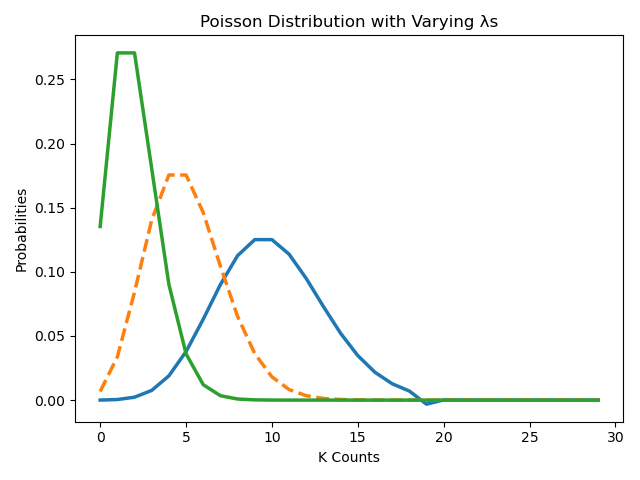Poisson Distribution
The poisson distribution models the probability of random events ( random variable ) that happen within a given time interval. For example, the number of children born every hour can likely be modelled with the poisson distribution.
Mathematically, the poisson distribution is symbolized as:
$$ X \sim Poisson_{\lambda}$$
where:
$\lambda$: is the expected value/rate of events of the random variable.
More generally, the poisson distribution models a random variable whose:
- Events can be counted within the time interval
- The rate of events is established/known within the interval
- Events are independent with each other within the time interval
Poisson Random Variable
As we see above, the poisson distribution takes on a parameter which is the rate of events $\lambda$. The resulting output is the count of observations that are drawn from a poisson distribution with the specified $\lambda$ value - in this case $2.5$.
from scipy.stats import poisson
poisson_rv = poisson.rvs(2.5, size=100)
poisson_rvVisualizing the Poisson Distribution
To help visualize the poisson distribution, we use a combination of possible events from the probability mass function to demonstrate the shape of the poisson distribution based on different $\lambda$ parameters. We do this at:
$\lambda$ = 10
$\lambda$ = 5
$\lambda$ = 1
import numpy as np
import matplotlib.pyplot as plt
from scipy.special import factorial
# Event Counts
x = np.arange(0, 30, 1)
poisson_rv_1 = ((10**x)*np.exp(-10))/factorial(x, exact=True)
poisson_rv_2 = ((5**x)*np.exp(-5))/factorial(x, exact=True)
poisson_rv_3 = ((2**x)*np.exp(-2))/factorial(x, exact=True)
plt.plot(x, poisson_rv_1, label='λ = 10', linewidth=2.5, linestyle='-')
plt.plot(x, poisson_rv_2, label='λ = 5', linewidth=2.5, linestyle='--')
plt.plot(x, poisson_rv_3, label='λ = 2', linewidth=2.5, linestyle='-')
plt.title('Poissob Distriubtion with Varying λs')
plt.xlabel('K Counts')
plt.ylabel('Probabilities')
Notice the shape of the distribution as the $\lambda$ increases. The distribution center moves to the right and the variance increases with higher $lambda$ values.